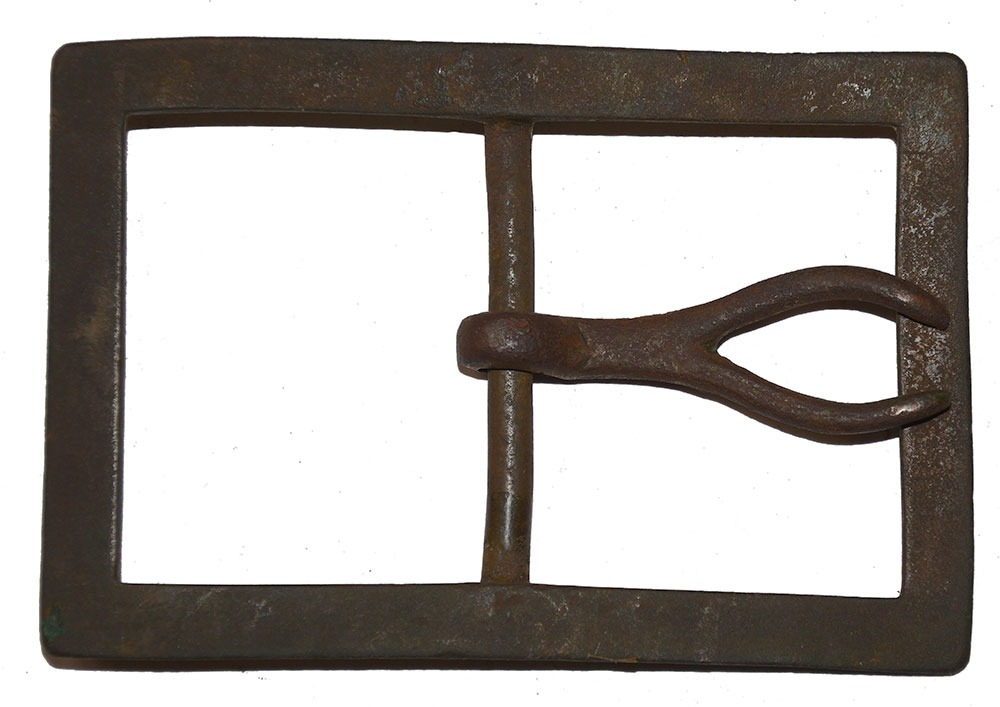site search
online catalog
CONFEDERATE LARGE FRAME FORKED-TONGUE, “WISHBONE” BUCKLE FROM PEACHTREE CREEK, ATLANTA CAMPAIGN, EX DON PHILLIPS

$895.00 ON HOLD
Quantity Available: 1
Item Code: 2024-2377
One of the more distinctive Confederate belt buckles is the frame pattern with a movable spit tongue sometimes called the “forked tongue” or “wishbone” pattern. The buckle is simple, practical, and lightweight, meant to have a plain leather belt sewn around the center bar that would be pierced with two rows of holes to spread the stress on the belt from a cap box, bayonet (perhaps,) and possibly a cartridge box. These were easily made with both frame and tongue made of sand cast brass and were thus widely produced and in a variety of sizes. This is a large size, measuring 68mm by 100mm. See Mullinax and Keim’s volumes for examples, especially figures 393-424 in Keim’s Confederate General Service Accoutrement Plates, who also shows a couple of examples on their original belts and several great images of armed Confederates wearing them. Along with fixed tongue buckles, they are perhaps the closest the Confederate army came to a counterpart to the oval U.S. as a general service belt buckle.
This one was very well made. The face of the frame was file-finished smooth, with clean edges, slightly rounded corners and sharp interior corners, and shows as a smooth, light brown. The center bar was cast raised on the reverse and the ends were beveled. The tongue was cast rounded on the upper side and flat on the bottom, but with the lower edges slightly beveled. The two branches flare out and then curve symmetrically and rather gracefully back toward one another. The underside is only slightly less well finished than the face. The center bar shows only the slightest deviation from a straight line and the frame has a slight wave on the upper left when viewed from the front with the wishbone prongs closed in the short side bar at the right.
This comes from the collection of Don Phillips and was recovered on the Peachtree Creek battlefield, fought July 20, 1864, where Hood, recently appointed to replace Johnston, launched a two-corps assault on the Union 14th and 20th Corps, along with a division of the 4th Corps, just north of Atlanta (and now part of Atlanta.) Hood hoped to catch Sherman’s troops while they were in the process of fording the creek, but delays and other problems allowed Union troops to prepare and despite some temporary, limited successes, Confederate assaults were a failure at a cost of some 2,500 to Union losses of about 1,750.
This is a great example of a widely used Confederate buckle shows off very well and would look good in a plate collection, CS infantry display, or one devoted specifically to the Army of Tennessee and the Atlanta Campaign. [sr][ph:L]
~~~~~~~~~~~~~~~~~~~~~~~~~~~~~~~~~~~
THIS ITEM, AS WITH ALL OTHER ITEMS AVAILABLE ON OUR WEB SITE,
MAY BE PURCHASED THROUGH OUR LAYAWAY PROGRAM.
CLICK HERE FOR OUR POLICIES AND TERMS.
THANK YOU!
Inquire About CONFEDERATE LARGE FRAME FORKED-TONGUE, “WISHBONE” BUCKLE FROM PEACHTREE CREEK, ATLANTA CAMPAIGN, EX DON PHILLIPS
For inquiries, please email us at [email protected]
Most Popular
Historical Firearms Stolen From The National Civil War Museum In Harrisburg, Pa »
Theft From Gravesite Of Gen. John Reynolds »
Selection Of Unframed Prints By Don Troiani »
Fine Condition Brass Infantry Bugle Insignia »
British Imported, Confederate Used Bayonet »
Scarce New Model 1865 Sharps Still In Percussion Near Factory New »
featured item
A RARE SURVIVOR: EARLY-WAR CONFEDERATE MARKED BRITISH P53 ARTILLERY CARBINE #1500 WITH A TENNESSEE PROVENANCE
British artillery carbines were used by both Confederate cavalry and infantry: in October 1862 Jeb Stuart wanted to exchange rifles carried by some his troopers for “Enfield carbines (artillery) in the hands of our infantry.” This is one of just… (846-571). Learn More »
site search
Upcoming Events
May 16 - 18: N-SSA Spring Nationals, Fort Shenandoah, Winchester, VA Learn More »







